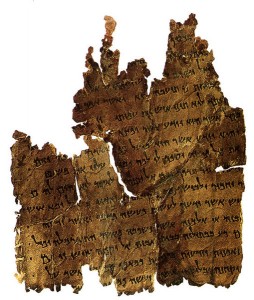Composition and Redaction of the Dead Sea Scrolls
 Composition
Composition
The Scrolls give us information about the composition of only one type of literature, collections of laws called serakhim.[1] These laws were derived from Scripture by halakhic midrash and then organized into serakhim, lists of laws on a topic, and often provided with titles like, “Regarding Forbidden Consanguineous Marriages.”[2] Such topical collections are in some ways forerunners of the later orally redacted Mishnaic tractates on their earlier oral proto-tractates. We know that the collectors of larger halakhic compositions found at Qumran had such serakhim available. Similarly composed “mini-rules,” stemming from the sectarian assembly (moshav ha-rabbim),[3] seem to underlie the collections of sectarian rules included in the various rule scrolls.
Redaction
Quite a number of Dead Sea Scrolls texts show evidence of redaction that enable us to learn about this process. Specifically, since all the major sectarian compositions survive in more than one recension, in which different components are variously assembled, it becomes clear that the larger texts were assembled from sources that originally circulated as independent units. This is certainly true about the Damascus Document (Zadokite Fragments),[4] Rule of the Community,[5] War Scroll,[6] the Berakhot texts,[7] and Hodayot[8]—among the most significant sectarian scrolls. It is also the case with the Temple Scroll, the sources of which are easily recognized.[9] But comparison with the expanded Pentateuch scrolls shows that some raw material got into both redactions.[10] Perhaps the best example is the penal code that appears in various versions in three different texts.[11]
In the area of biblical text, several texts are clearly preserved in more than one literary edition.[12] The Scrolls preserve both proto-Masoretic and proto-Septuagintal editions of Samuel, but Chronicles is based on another edition, different from the canonical Samuel. The Scrolls preserve in Hebrew both proto-Masoretic Jeremiah and proto-Septuagintal. In the case of Psalms, we can see that the order was not yet standard in different editions. In the view of some scholars, an expanded version circulated as well, with texts not part of our canonical Psalms. We do not discuss here the issues of lower biblical criticism occasioned by the existence of various text types and minor textual variations.
[1] Schiffman, Halakhah at Qumran, 60-68.
[2] L. H. Schiffman, “Legal Texts and Codification in the Dead Sea Scrolls,” in Discussing Cultural Influences: Text, Context, and Non-text in Rabbinic Judaism (ed. R. Ulmer; Studies in Judaism; Lanham, Md.: University Press of America, 2007) 1-39.
[3] Schiffman, Halakhah at Qumran, 68-72.
[4] C. Hempel, The Laws of the Damascus Document: Sources, Tradition and Redaction (STDJ 29; Leiden: E. J. Brill, 1998).
[5] S. Metso, The Textual Development of the Qumran Community Rule (STDJ 21; Leiden: E. J. Brill, 1997).
[6] P. R. Davies, 1QM, the War Scroll from Qumran: Its Structure and History (BibOr 32 ; Rome: Biblical Institute Press, 1977).
[7] B. Nitzan, “The Benedictions from Qumran for the Annual Covenantal Ceremony,” in The Dead Sea Scrolls, Fifty Years after Their Discovery: Proceedings of the Jerusalem Congress, July 20-25, 1997 (ed. L. H. Schiffman, E. Tov and J. C. VanderKam; Jerusalem: Israel Exploration Society in cooperation with the Shrine of the Book, Israel Museum, 2000) 263-271.
[8] E. M. Schuller, “The Cave 4 Hodayot Manuscripts: A Preliminary Description,“ in Qumranstudien: Vorträge und Beiträge der Teilnehmer des Qumranseminars auf dem internationalen Treffen der Society of Biblical Literature, Münster, 25.-26. Juli 1993 (ed. H.-J. Fabry, A.Lange and H. Lichtenberger; Schriften des Institutum Judaicum Delitzschianum 4; Göttingen: Vandenhoeck & Ruprecht, 1996) 87-100; idem, “The Classification Hodayot and Hodayot-like (with Particular Attention to 4Q433, 4Q433a and 4Q440),” in Sapiential, Liturgical and Poetical texts from Qumran: Proceedings of the Third Meeting of the International Organization for Qumran Studies, Oslo 1998, Published in Memory of Maurice Baillet (ed. D. K. Falk, F. García Martínez and E. M. Schuller (STDJ 35; Leiden: Brill, 2000)182-193.
[9] A. M. Wilson and L. Wills, “Literary Sources of the Temple Scroll,” HTR 75 (1982): 275-88; M. O. Wise, A Critical Study of the Temple Scroll from Qumran Cave 11 (SAOC 49; Chicago: Oriental Institute of the University of Chicago, 1990; L. H. Schiffman, “The Deuteronomic Paraphrase of the Temple Scroll,” RevQ 15 (1992): 543-68.
[10] This is also the case, for example, with certain laws that are in the Damascus Document and Miscellaneous Rules.
[11] J. M. Baumgarten, “The Cave 4 Versions of the Qumran Penal Code,” JJS 43 (1992): 268-76.
[12] E. C. Ulrich, “Multiple Literary Editions: Reflections toward a Theory of the History of the Biblical Text,” in Current Research and Technological Developments on the Dead Sea Scrolls: Conference on the Texts from the Judean Desert, Jerusalem, 30 April 1995 (ed. D. W. Parry and S. D. Ricks; STDJ 20; Leiden: E. J. Brill, 1996) 78-105.

Leave a Reply